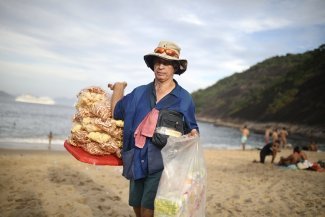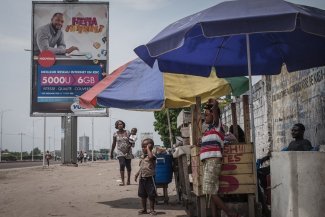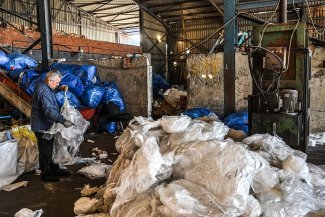
White sand beaches. Yoga retreats. Mayan ruins. The Mexican beach town of Tulum is sold as an eco-chic paradise where you can disconnect from the stresses of modern life.
A closer look reveals a dark underbelly.
When activist Carlos Meade moved from Mexico City to the Caribbean coast in Quintana Roo state in the early 1980s, it was largely untouched. Turtles made their nests undisturbed on hundreds of miles of empty beaches stretching from the city of Cancun to the border with Belize, lined with mangroves that gave way to virgin forests. A unique system of underground rivers channelled water from across the Yucatan peninsula to the Caribbean Sea, where the second-longest coral reef in the world snaked down the coast to the waters of Belize, Guatemala and Honduras.
Since then the story of the Riviera Maya has been one of turbo-charged, chaotic growth.
Mexican government statistics show that 4.7 million tourists visited the region in 2016, roughly equivalent to the population of Ireland, and migrant workers from Mexico’s poorest areas have flocked to the region in search of work.
Where small indigenous Maya communities once lived, there are now 5,000-room resorts that receive guests from all over the world. The falling cost of air travel and the rise of package tourism has made Cancun airport the second busiest in Mexico, and a wave of development has placed incredible pressure on communities and the environment.
“The changes to the countryside have been so fast and violent that it’s difficult to take in,” Meade told Equal Times. “Just 25 years ago the Tulum-Cancun highway was a narrow road with no hard shoulder. The branches of trees on both sides formed a tunnel of vegetation as they met in the middle.”
These days thousands of vehicles per day hurtle down a dual carriageway that slices through the forest and skirts national parks, disgorging tourists and workers alike.
First, the tsunami of development came to Cancun, then Playa del Carmen, cutting down forests and ripping up mangroves as it moved inexorably down the coast. In 2006, Playa del Carmen was believed to be one the fastest growing city in the world.
Now Tulum is on the front line, a small town whose population tripled from 10,000 to 30,000 from 2008 to 2015, with projections for continued growth a worry for environmentalists.
A deficient legal framework
Meade is the director of Yaxché, Tree of Life, an NGO that is part of the Sustainable Tulum Network made up of civil society organisations working to protect the environment.
The issues discussed at their weekly meetings are terrifying: uncontrolled development destroying forests and mangroves, untreated sewage polluting the water table and the sea, illegal dumping grounds springing up on the outskirts of town. The problems are massive, and the activists are unequivocal in where the blame lies.
“The chaos stems from a deficient legal framework, but most of all the lack of ability and political will of the authorities,” said Meade, adding that unscrupulous developers have been able to take advantage of Mexico’s corrupt and inefficient bureaucracy. The environmentalists say that they are fighting against a corrupt local government that sells sensitive natural areas to the highest bidder, and has done little to control migrants who cut down the forest to make informal settlements without access to water, sewage or refuse collection.
Despite repeated attempts, local authorities in Tulum did not respond to a request for comment for this article.
Javier Peralta, president of the local NGO Contraloría Ciudadana, told Equal Times that corruption makes the law impotent and discourages people from speaking out.
“Quintana Roo is one of the states with the largest number of environmental laws in Mexico, but the law isn’t applied,” he said. “People ask ‘Why would I file a report if they won’t do anything.’ This is the sad reality of Mexico.”
Those that do raise concerns are often targeted, and reports of threats and intimidation are common.
In an emblematic case, activist Araceli Domínguez of the Grupo Ecologista del Mayab (GEMA) was detained in 2005 for protesting against the construction of new hotels, and fears of similar arbitrary detentions remain today.
With the rule of law shaky and powerful business interests willing to exert their influence over authorities, locals are reluctant to speak on the record for fear of reprisals. As a result, activists are concentrating on building a popular movement rather than one with prominent leaders.
The group is working to promote awareness of environmental issues, and build pressure on authorities to regulate developments and enforce the law governing existing ones. There have been notable successes in the region in protecting the mangroves at Tajamar and slowing development at Xcacel, and the activists are using that knowhow in the Tulum area.
Proposed developments are obliged to undergo an environmental impact assessment and public consultations are required by law, but the problem of enforcement remains.
Stopping massive new developments is the priority for activists. As things stand there are around 50,000 hotel rooms on the Riviera Maya, and there are plans to double this number in the next few years.
Precarious working conditions
According to Meade, each hotel room brings 18 migrants to the area thanks to direct and indirect employment opportunities. If the plans come to fruition, that would mean 900,000 more permanent residents in an area that already has serious problems in managing both solid and liquid waste, plus the destruction of forests and mangroves to build housing and hotels.
Concerns have also been raised over the working conditions of migrant workers who work in construction and hospitality. Recognising that some fear for their jobs if they speak out, Peralta set up an anonymous drop box for people to report labour abuses safely. He found that workers are employed on insecure, short-term contracts, with unpaid overtime a common complaint.
“The pay is low and the contracts are renewed every month or every three months,” said Peralta. “The hotels don’t hire workers directly, they use outsourcing companies. These intermediary companies prevent workers from forming unions or demanding protections.”
While information on labour conditions is hard to come by, environmentalists have the data at their disposal.
In an effort to appeal to developers, researchers such as Greenpeace Oceans campaigner and biologist Dr Miguel Rivas from the National Autonomous University of Mexico (UNAM) are pointing out that uncontrolled development is spoiling the natural attractions that bring in visitors.
“In Tulum and the Riviera Maya in general we are worried by a growth model that doesn’t take into account the carrying capacity of the area,” he wrote in an email to Equal Times. “In destroying the same natural attractions that it tries to sell, the area is killing the goose that lays the golden eggs.”
The worry is that appealing to long-term planning will have no effect on investors.
According to Meade, most hotel groups look for a return on investment of two to three years. “As a result of this short-term thinking, investors have no interest or commitment to the future of the destination,” he said.
Peralta is equally damning in his assessment of the developers. “They don’t care how the place ends up. They will find a new place and destroy that too,” he said.
As Meade and researcher Magali Daltabuit Godas wrote in their book The Environmental Movement in Quintana Roo: “The city of Tulum is currently a kind of social laboratory in which the future of the Mexican Caribbean as a sustainable project is at stake.”








